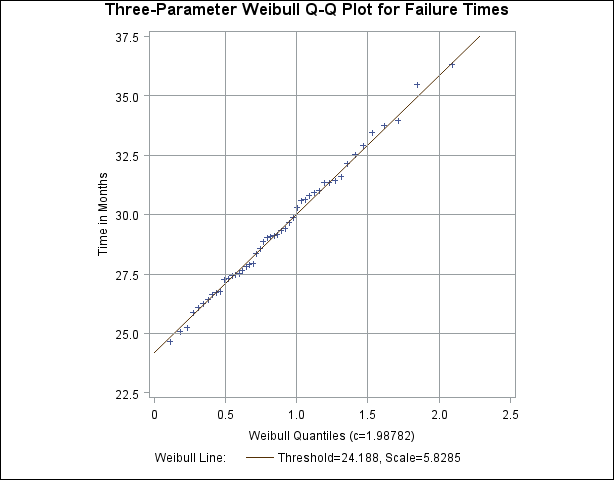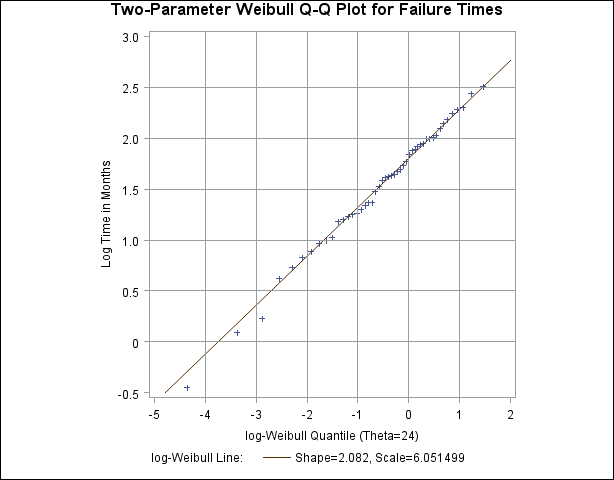QQPLOT Statement: CAPABILITY Procedure
Example 5.23 Comparing Weibull Q-Q Plots
This example compares the use of three-parameter and two-parameter Weibull Q-Q plots for the failure times in months for 48 integrated circuits. The times are assumed to follow a Weibull distribution.
data Failures; input Time @@; label Time='Time in Months'; datalines; 29.42 32.14 30.58 27.50 26.08 29.06 25.10 31.34 29.14 33.96 30.64 27.32 29.86 26.28 29.68 33.76 29.32 30.82 27.26 27.92 30.92 24.64 32.90 35.46 30.28 28.36 25.86 31.36 25.26 36.32 28.58 28.88 26.72 27.42 29.02 27.54 31.60 33.46 26.78 27.82 29.18 27.94 27.66 26.42 31.00 26.64 31.44 32.52 ;
Three-Parameter Weibull Plots
[See CAPQQ3 in the SAS/QC Sample Library]If no assumption is made about the parameters of this distribution, you can use the WEIBULL option to request a three-parameter Weibull plot. As in the previous example, you can visually estimate the shape parameter  by requesting plots for different values of
by requesting plots for different values of  and choosing the value of
and choosing the value of  that linearizes the point pattern. Alternatively, you can request a maximum likelihood estimate for
that linearizes the point pattern. Alternatively, you can request a maximum likelihood estimate for  , as illustrated in the following statements produce Weibull plots for
, as illustrated in the following statements produce Weibull plots for  1, 2 and 3:
1, 2 and 3:
ods graphics off;
symbol v=plus;
title 'Three-Parameter Weibull Q-Q Plot for Failure Times';
proc capability data=Failures noprint;
qqplot Time / weibull(c=est theta=est sigma=est)
square
href=0.5 1 1.5 2
vref=25 27.5 30 32.5 35;
run;
Note: When using the WEIBULL option, you must either specify a list of values for the Weibull shape parameter  with the C= option, or you must specify C=EST.
with the C= option, or you must specify C=EST.
Output 5.23.1 displays the plot for the estimated value  . The reference line corresponds to the estimated values for the threshold and scale parameters of (
. The reference line corresponds to the estimated values for the threshold and scale parameters of ( =24.19 and
=24.19 and  =5.83, respectively.
=5.83, respectively.


Two-Parameter Weibull Plots
[See CAPQQ3 in the SAS/QC Sample Library]Now, suppose it is known that the circuit lifetime is at least 24 months. The following statements use the threshold value  to produce the two-parameter Weibull Q-Q plot shown in Output 5.23.2:
to produce the two-parameter Weibull Q-Q plot shown in Output 5.23.2:
symbol v=plus;
title 'Two-Parameter Weibull Q-Q Plot for Failure Times';
proc capability data=Failures noprint;
qqplot Time / weibull2(theta=24 c=est sigma=est) square
href= -4 to 1
vref= 0 to 2.5 by 0.5;
run;
The reference line is based on maximum likelihood estimates  =2.08 and
=2.08 and  =6.05. These estimates agree with those of the previous example.
=6.05. These estimates agree with those of the previous example.


